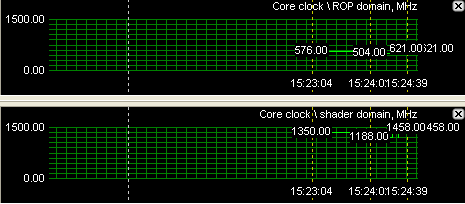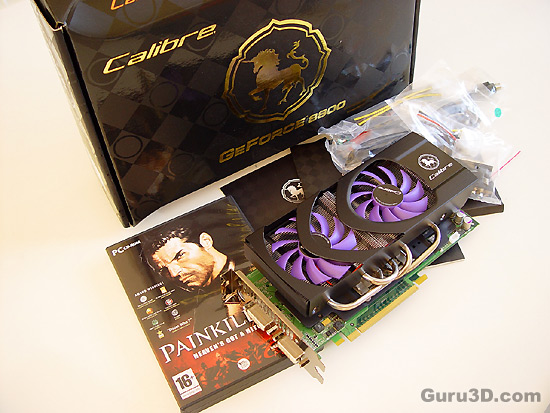Page 2
Let's start with my standard bit about the GeForce 8800 GTS 320MB. The best way to look at a (new) product and get an understanding where it is performance wise is by looking at it's price and then compare that price with other products to understand the dynamics without looking at technical specifications first. It establishes a good perspective of product positioning. Have a look:
- GeForce 8800 GTX - $599
- GeForce 8800 GTS - $449
- GeForce 8800 GTS - $309 (320 MB)
- GeForce 7950 GT - $299
- GeForce 7900 GS - $199
- GeForce 7600 GT - $159
- GeForce 7600 GS - $129
- GeForce 7300 GPUs - <$99
Since not everyone can afford to cough up half their monthly salary to play games, this is where the GeForce 8800 GTS 320MB surfaces. Fact is that the 640 MB product has been selling in rather unpleasant numbers. The 640 MB model is targeted at 449 USD, people simply decided to invest more money and go for the flagship card, the GTX. So NVIDIA scratched behind their NVIDIA logo'd ears and had to do something about that. It's goes something like this: the two most expensive and important items on a graphics card are the graphics chipset and the memory. You can understand that leaving the graphics core intact 100% yet saving money on the memory has a rather unusual and special effect. You'll get the RAW performance of the GPU, yet you'll be limited to play in uber-high resolutions or in instances where the GPU has to manage complex memory dependant operations (AA for example).
Core frequency then: Any GTS model will come with a 500 MHz core clock at standard (overclocked editions are obviously faster) and thus now will be available in a 640 and 320 MB version. The memory at standard is clocked at 800 (1600 effective) as well.
Other than that we'll now get to the Unified Shaders slash streaming processors (please read our reference 8800 GTS/GTX review if you want to learn about the new architecture). The sheer number of these units as you know has been cut down from 128 (GTX) to 96 shader cores for the GTS. Bare in mind though that the number of Shader processors (96) is exactly the same as on the 640 MB model as it is on this new 320 Mb model. So you have a 100% similar graphics core on this 320 Mb model, and that's like chocolate in a golden wrapper as everybody expected the number of shader processors to be downsized as well. Even the shader domain clock frequency is clocked 100% similar to the 640 MB model at 1200 MHz.
Since we are talking about a state of the art product series 8 product you can expect certain features for granted; the 320 MB GTS is a HDCP compliant product, it has support for two high-res monitors with the help of Dual-Link DVI. Also the standard VIVO options including HDTV output are present. So this is a HD ready product in all ways.
Some generic facts:
- All NVIDIA GeForce 8800 GTX and GeForce 8800 GTS-based graphics cards are HDCP capable.
- The GeForce 8 Series GPUs are not only the first shipping DirectX 10 GPUs, but they are also the reference GPUs for DirectX 10 API development and certification and are 100% DirectX 9 compatible.
- GeForce 8800 GPUs deliver full support for Shader Model 4.0.
- All graphics cards are being built by NVIDIAs contract manufacturer.
- All GeForce 8800 GPUs support NVIDIA SLI technology.
- The NVIDIA GeForce 8800 GTX has a 24 pixel per clock ROP. The GeForce 8800 GTS has a 20 pixel per clock ROP.
- GeForce 8800 GTX requires a minimum 450W or greater system power supply (with 12V current rating of 30A). GeForce 8800 GTS requires a minimum 400W or greater system power supply (with 12V current rating of 26A).
| GeForce 8800 GTX | GeForce 8800 GTS | |
| Stream (Shader) Processors |
128 |
96 |
|
Core Clock (MHz) |
575 |
500 |
|
Shader Clock (MHz) |
1350 |
1200 |
|
Memory Clock (MHz) x2 |
900 |
800 |
|
Memory amount |
768 MB |
320/640 MB |
|
Memory Interface |
384-bit |
320-bit |
|
Memory Bandwidth (GB/sec) |
86.4 |
64 |
|
Texture Fill Rate (billion/sec) |
36.8 |
24 |
In the photo shoot we'll have a closer look at all three products and tell you a little about connectivity and also that memory mystery.
Sparkle Calibre P880LV (GeForce 8800 GTS 320 MB w/TEC)
So here's where we arrive at Sparkle. The Calibre P880LV edition is not quite a regular GeForce 8800 GTS card. It's pretty much the same PCB and G80 processor .. but that's it. Sparkle overclocked it right out of the box, they also have replaced the regular reference cooler with a TEC active cooler system on the card.
It's a bit of a controversial idea as TEC has a lot of positives .. yet also negatives. I'll get into that later. There are two companies responsible for this product. Sparkle doing the actual video card and then MACS Technology who builds the TEC Active cooling. We actually recently tested the cooler shortly ago and I was not too fond of it. Ever since that review some things have changed in a positive manner though.
The reference model GeForce 8800 GT runs at 500 MHz and it's memory is clocked at 1600 MHz. This P880LV is clocked at 575 MHz on the core and it's memory at 1780 MHz. So it has a pre-clock as well.
There seems to be some confusion about the shader cores. There are three primary clock frequencies running in the G80 GPU. Core/Memory and shader domain. People think that the shader domain is not overclocked, that's wrong as they always they do. Take rivatuner for example as it can monitor that. Let me show you tree clock stages:
 |
||
Now here you can see that with the 575 MHz, the shader domain runs at 1350 MHz
- When I clock back the core to 500, the shader domain drops to 1188 MHz
- When I clock up to 621 MHz the shader domain is pumped up towards 1458 MHz
So overclocking the core frequency will overclock your shader domain as well based on a certain Shader clock ratio. I verified this with several people, among them the programmer of Rivatuner. It is completely done at driver or BIOS level based on a multiplier ratio.
Back on topic .. So that's a really nice default overclock, it will give some great additional performance over the standard clocked models.
Included in the box you'll find next to the Calibre GeForce 8800 GTS 320MB graphics card the following items:
- Quick install guide
- Manual
- DVI-I to VGA dongle
- HDTV dongle
- 4-pin to single 6-pin power cable
- Driver CD, which includes NVIDIA® ForceWare unified graphics drivers, Full installation manual .pdf
- Painkiller: Full version
 |
||
So that's quite a nice bundle. Painkiller however is a little too outdated in my opinion but hey .. it is a full version which nice value right ?
If you look closer at the card the first thing you'll notice is the MACs TEC cooler. In the actual photoshoot you'll notice .. it's blocking the SLI connector. From what I heard, Sparkle is working on a free new SLI bridge that is higher. But until I have word on that thing being released .. I can say only this .. if you plan to go SLI; you should not be buying this product at the moment.
| Standard | eVGA KO ACS³ | XFX XXX edition | Calibre 880LV | BFG OC edition | |
|
Stream (Shader) Processors |
96 |
96 |
96 |
96 |
96 |
|
Core Clock (MHz) |
500 |
590 |
580 |
575 |
540 |
|
Shader Clock (MHz) |
1200 |
1450 |
1450 |
1350 |
1300 |
|
Memory Clock (MHz) x2 |
800 |
920 |
900 |
890 |
800 |
|
Memory amount |
320 MB |
320 MB |
320 MB |
320 MB |
320 MB |
|
Memory Interface |
320-bit |
320-bit |
320-bit |
320-bit |
320-bit |
The cooler itself is basically a Peltier unit with heat pipe construction to remove the heat. The heat is guided to cooling ribbons where no less than two fans blow over these ribbons. In the photoshoot I'll show you guys some stuff. Obviously we'll be measuring heat and tweaking options as well.
Last thing yet good to know, Calibre products come with a 48 hours response technical support and 3 years warranty.
